- Home
- Jane Austen
Pride and Prejudice (Barnes & Noble Classics Series)
Pride and Prejudice (Barnes & Noble Classics Series) Read online
Table of Contents
From the Pages of Pride and Prejudice
Title Page
Copyright Page
Jane Austen
The World of Jane Austen and Pride and Prejudice
Introduction
Volume the First
Chapter 1
Chapter 2
Chapter 3
Chapter 4
Chapter 5
Chapter 6
Chapter 7
Chapter 8
Chapter 9
Chapter 10
Chapter 11
Chapter 12
Chapter 13
Chapter 14
Chapter 15
Chapter 16
Chapter 17
Chapter 18
Chapter 19
Chapter 20
Chapter 21
Chapter 22
Chapter 23
Volume the Second
Chapter 1
Chapter 2
Chapter 3
Chapter 4
Chapter 5
Chapter 6
Chapter 7
Chapter 8
Chapter 9
Chapter 10
Chapter 11
Chapter 12
Chapter 13
Chapter 14
Chapter 15
Chapter 16
Chapter 17
Chapter 18
Chapter 19
Volume the Third
Chapter 1
Chapter 2
Chapter 3
Chapter 4
Chapter 5
Chapter 6
Chapter 7
Chapter 8
Chapter 9
Chapter 10
Chapter 11
Chapter 12
Chapter 13
Chapter 14
Chapter 15
Chapter 16
Chapter 17
Chapter 18
Chapter 19
Endnotes
Inspired by Pride and Prejudice
Comments & Questions
For Further Reading
From the Pages of
Pride and Prejudice
It is a truth universally acknowledged, that a single man in possession of a good fortune must be in want of a wife. (page 5)
“You mistake me, my dear. I have a high respect for your nerves. They are my old friends. I have heard you mention them with consideration these twenty years at least.” (page 7)
“Pride relates more to our opinion of ourselves; vanity to what we would have others think of us.” (page 21)
“Happiness in marriage is entirely a matter of chance.” (page 24)
“I wonder who first discovered the efficacy of poetry in driving away love!” (page 45)
“To find a man agreeable whom one is determined to hate! Do not wish me such an evil.” (page 91)
“Those who do not complain are never pitied.” (page 113)
Without thinking highly either of men or of matrimony, marriage had always been her object: it was the only honourable provision for well-educated young women of small fortune, and, however uncertain of giving happiness, must be their pleasantest preservative from want. (page 122)
“Stupid men are the only ones worth knowing, after all.” (page 154)
They parted at last with mutual civility, and possibly a mutual desire of never meeting again. (page 229)
She found, what has been sometimes found before, that an event to which she had looked forward with impatient desire, did not, in taking place, bring all the satisfaction she had promised herself. It was consequently necessary to name some other period for the commencement of actual felicity; to have some other point on which her wishes and hopes might be fixed, and by again enjoying the pleasure of anticipation, console herself for the present, and prepare for another disappointment. (page 232)
“How strange this is! And for this we are to be thankful. That they should marry, small as is their chance of happiness, and wretched as is his character, we are forced to rejoice!” (page 294)
She was convinced that she could have been happy with him, when it was no longer likely they should meet. (page 301)
“You must learn some of my philosophy. Think only of the past as its remembrance gives you pleasure.” (page 356)
“I am the happiest creature in the world. Perhaps other people have said so before, but no one with such justice. I am happier even than Jane; she only smiles, I laugh.” (page 369)
Published by Barnes & Noble Books
122 Fifth Avenue
New York, NY 10011
www.barnesandnoble.com/classics
Pride and Prejudice was first published in 1813.
Originally published in mass market paperback format in 2003 by Barnes &
Noble Classics with new Introduction, Notes, Biography, Chronology,
Inspired By, Comments & Questions, and For Further Reading.
Trade paperback edition published in 2004.
Introduction, Notes, and For Further Reading
Copyright © 2003 by Carol Howard.
Note on Jane Austen, The World of Jane Austen and Pride and Prejudice,
Inspired by Pride and Prejudice, and Comments & Questions
Copyright © 2003 by Barnes & Noble, Inc.
All rights reserved. No part of this publication may be reproduced or transmitted in any form or by any means, electronic or mechanical, including photocopy, recording, or any information storage and retrieval system, without the prior written permission of the publisher.
Barnes & Noble Classics and the Barnes & Noble Classics
colophon are trademarks of Barnes & Noble, Inc.
Pride and Prejudice
ISBN-13: 978-1-59308-201-7 ISBN-10: 1-59308-201-0
eISBN : 978-1-411-43296-3
LC Control Number 2004100759
Produced and published in conjunction with:
Fine Creative Media, Inc.
322 Eighth Avenue
New York, NY 10001
Michael J. Fine, President and Publisher
Printed in the United States of America
Jane Austen
The English novelist Jane Austen was born December 16, 1775, the seventh of eight children, in the Parsonage House of Steventon, Hampshire, where she spent her first twenty-five years. During her brief lifetime Austen witnessed political unrest, revolution, war, and industrialization, yet these momentous events are not the central subjects of her finely focused novels. Rather, Austen wrote of her immediate experience: the microcosm of the country gentry and its class-conscious insularity. Jane’s father, the Reverend George Austen, was the erudite country rector of Steventon, and her mother, Cassandra (née Leigh), was descended from an aristocratic line of learned clergymen. By no means wealthy, the Austens nonetheless enjoyed a comfortable, socially respectable life, and greatly prized their children’s education.
Jane and her beloved elder (and only) sister, Cassandra, were schooled in Southampton and Reading for a short period, but most of their education took place at home. Private theatrical performances in the barn at Steventon complemented Jane’s studies of French, Italian, history, music, and eighteenth-century fiction. An avid reader from earliest childhood, Jane began writing at age twelve, no doubt encouraged by her cultured and affectionate family. Indeed, family and writing were her great loves; despite a fleeting engagement in 1802, Austen never married. Her first two novels, “Elinor and Marianne” and “First Impressions,” were written while at Steventon but never published in their original form.
Following her father’s retirement, Jane moved in 1801 with her
parents and sister to Bath. That popular watering hole, removed from the country life Jane preferred, presented the sociable young novelist with a wealth of observations and experience that would later emerge in her novels. Austen moved to Southampton with her mother and sister after the death of her father in 1805. Several years later the three women settled in Chawton Cottage in Hampshire, where Austen resided until the end of her life. She relished her return to the countryside and, with it, a renewed artistic vigor that led to the revision of her early novels. Sense and Sensibility, a reworking of “Elinor and Marianne,” was published in 1811, followed by Pride and Prejudice, a reworking of “First Impressions,” two years later.
Austen completed four more novels (Mansfield Park, Emma, Northanger Abbey, and Persuasion) in the Chawton sitting room. Productive and discreet, she insisted that her work be kept secret from anyone outside the family. All of her novels were published anonymously, including the posthumous release, thanks to her brother Henry, of Northanger Abbey and Persuasion .
The last years of Austen’s life were relatively quiet and comfortable. Her final, unfinished work, Sanditon, was put aside in the spring of 1817, when her health sharply declined and she was taken to Winchester for medical treatment of what appears to have been Addison’s disease or a form of lymphoma. Jane Austen died there on July 18, 1817, and is buried in Winchester Cathedral.
The World of Jane Austen and Pride and Prejudice
1775 The American Revolution begins in April. Jane Austen is born on December 16 in the Parsonage House in Steventon, Hampshire, England, the seventh of eight children (two girls and six boys).
1778 Frances (Fanny) Burney publishes Evelina, a seminal work in the development of the novel of manners.
1781 German philosopher Immanuel Kant publishes his Critique of Pure Reason.
1782 The American Revolution ends. Fanny Burney’s novel Cecilia is published.
1783 Cassandra and Jane Austen begin their formal education in Southampton, followed by study in Reading.
1788 King George III of England suffers his first bout of mental illness, leaving the country in a state of uncertainty and anxiety. George Gordon, Lord Byron, is born.
1789 George III recuperates. The French Revolution begins. William Blake’s Songs of Innocence is published.
1791 American political philosopher Thomas Paine publishes the first part of The Rights of Man.
1792 Percy Bysshe Shelley is born. Mary Wollstonecraft publishes A Vindication of the Rights of Woman.
1793 A shock wave passes though Europe with the execution of King Louis XVI of France and, some months later, his wife, Marie-Antoinette; the Reign of Terror begins. England declares war on France. Two of Austen’s brothers, Francis (1774-1865) and Charles (1779- 1852), serve in the Royal Navy, but life in the countryside of Steventon remains relatively tranquil.
1795 Austen begins her first novel, “Elinor and Marianne,” written as letters (the fragments of this early work are now lost); she will later revise the material to become the novel Sense and Sensibility. John Keats is born.
1796-1797 Austen authors a second novel, “First Impressions,” which was never published; it will later become Pride and Prejudice.
1798 Poets Samuel Taylor Coleridge and William Wordsworth publish The Lyrical Ballads.
1801 Jane’s father, the Reverend George Austen, retires, and with the Napoleonic Wars looming in the background of British consciousness, he and his wife and two daughters leave the quiet country life of Steventon for the bustling, fashionable town of Bath. Many of the characters and depictions of society in Jane Austen’s subsequent novels are shaped by her experiences in Bath.
1803 Austen receives her first publication offer for her novel “Susan,” but the manuscript is subsequently returned by the publisher; it will later be revised and released as Northanger Abbey. The United States buys Louisiana from France. Ralph Waldo Emerson is born.
1804 Napoleon crowns himself emperor of France. Spain declares war on Britain.
1805 Jane’s father dies. Jane and her mother and sister subsequently move to Southampton. Sir Walter Scott publishes his Lay of the Last Minstrel.
1809 After several years of traveling and short-term stays in various towns, the Austen women settle in Chawton Cottage in Hampshire; in the parlor of this house Austen quietly composes her most famous works. Charles Darwin and Alfred, Lord Tennyson, are born.
1811 Austen begins Mansfield Park in February. In November Sense and Sensibility, the romantic misadventures of two sisters, is published with the notation “By a Lady”; all of Austen’s subsequent novels are also brought out anonymously. George III is declared insane, and the morally corrupt Prince of Wales (the future King George IV) becomes regent.
1812 Fairy Tales by the Brothers Grimm and the first parts of Lord Byron’s Childe Harold are published. The United States declares war on Great Britain.
1813 Pride and Prejudice is published; it describes the conflict between the high-spirited daughter of a country gentleman and a wealthy landowner. Napoleon is exiled to Elba, and the Bourbons are restored to power.
1814 Mansfield Park is published; it is the story of the difficult though ultimately rewarded life of a poor relation who lives in the house of her wealthy uncle.
1815 Austen’s comic novel Emma is published, centering on the heroine’s misguided attempts at matchmaking. Napoleon is defeated at Waterloo. Charlotte Brontë is born.
1817 Austen begins the satiric novel Sanditon, but abandons it because of declining health. She dies on July 18 in Winchester and is buried in Winchester Cathedral.
1818 Northanger Abbey, a social satire with overtones of (parodied) terror, and Persuasion, about a reawakened love, are published under Austen’s brother Henry’s supervision.
Introduction
Long before Austenmania overtook America and England in the mid-1990s, when major films and television miniseries were produced of Jane Austen’s most popular novel, Pride and Prejudice, and three other of the six novels Austen completed as an adult, fans reported a private, proprietary sense of “Jane,” as though the great English novelist were a close acquaintance. Rudyard Kipling exploited this phenomenon in his short story “The Janeites,” which describes several members of a secret Jane Austen society, a group of soldiers in the trenches of World War I, well versed in Austen trivia and gallant defenders of “Jane” and the world she created. Both the jealously guarded private fantasy and the recent popular cultural phenomenon may be attributed in part to the enduring power of Austen’s genius as a writer: her ability to create singular characters who linger in one’s imagination, her unparalleled sense of irony and wit, her brilliant dialogue, and her carefully woven plots. At the same time, Austen delivers a satisfying romance, more so in Pride and Prejudice than in her other novels, and the sheer happiness of her main characters at the novel’s end has its own appeal.
Above all though, and in Pride and Prejudice especially, Austen appeals to modern readers’ nostalgia for a world of social, moral, and economic stability, but one where characters are free to make their own choices and pursue their hearts’ desires. The formal civility, the carefully prescribed manners, and sexual and social restraint, set against a backdrop of village community, stately manor houses, and an English landscape devoid of industrial turmoil and the brisk pace of modern technology—these are a welcome escape for today’s reader. So, too, the heroine Elizabeth Bennet’s bold independence and insistence on placing individual preference above economic motive in marriage satisfies our desire for a plot shaped through the pursuit of personal fulfillment. A convention of morality tales of Austen’s time is that individuals’ personal freedoms and aspirations cannot be easily reconciled with their responsibilities to family and community. Austen overcomes this difficulty by employing the classic comic form: When wedding bells are about to ring at the story’s conclusion, we know that the two sets of main characters have made marriages of affection (Elizabeth’s sister Jane and Mr. Bingley) or
even passion (Elizabeth and Mr. Darcy) and that these happy unions actually enhance the stability of society. That it appears to the reader reasonable that Elizabeth follows her heart and ends up fabulously wealthy attests to Austen’s powers of crafting a story in which early hostilities and inappropriate desires are deftly reconciled, and far more realistically so than in comedies by Shakespeare, where happy resolutions must be effected either by wildly improbable coincidences or supernatural forces.
It is sometimes said that Austen’s gift was to be a shrewd observer of her narrow, genteel social circle, that her experience and knowledge of the world were limited and her life sheltered, and that her novels realistically reflect the peaceful late-eighteenth-and early-nineteenth century village community and English countryside she inhabited. That Austen was a careful observer of human motivation and social interaction is certainly true. One should not assume, though, that her choice to write novels of manners means that she was unaware of or unaffected by the political and social upheaval of her day. The idea that she centers her novels on the social classes with which she was most familiar is not entirely the case, although she had occasion to observe members of the gentry and aristocracy whose circumstances resembled those of some of the characters who populate her novels. Whether her own life was perfectly serene is questionable: Most lives, no matter how uneventful in retrospect, have their vicissitudes.

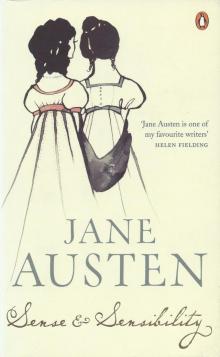 Sense and Sensibility
Sense and Sensibility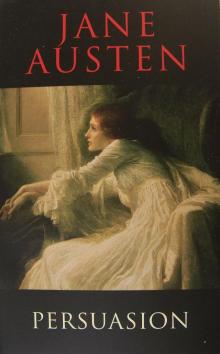 Persuasion
Persuasion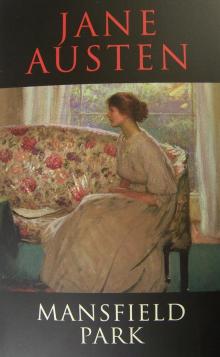 Mansfield Park
Mansfield Park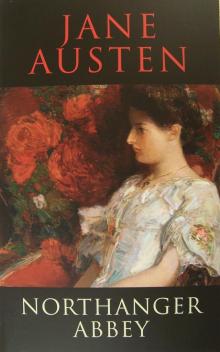 Northanger Abbey
Northanger Abbey Pride and Prejudice and Zombies
Pride and Prejudice and Zombies Pride and Prejudice
Pride and Prejudice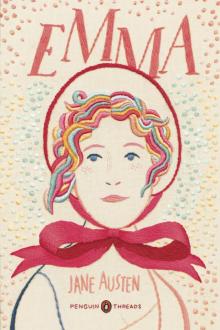 Emma
Emma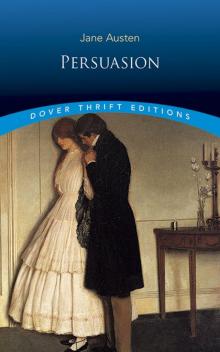 Persuasion (Dover Thrift Editions)
Persuasion (Dover Thrift Editions)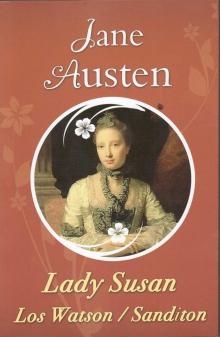 Lady Susan
Lady Susan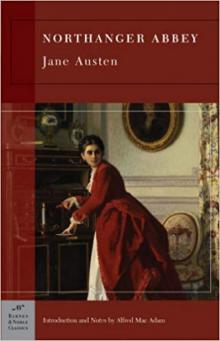 Northanger Abbey (Barnes & Noble Classics)
Northanger Abbey (Barnes & Noble Classics)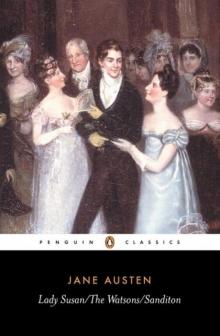 Lady Susan, the Watsons, Sanditon
Lady Susan, the Watsons, Sanditon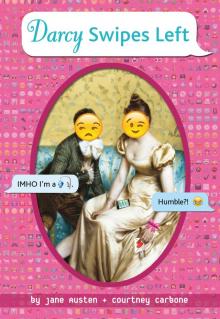 Darcy Swipes Left
Darcy Swipes Left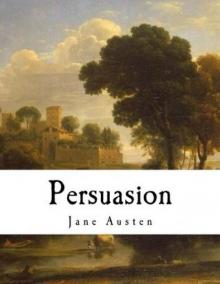 Persuasion: Jane Austen (The Complete Works)
Persuasion: Jane Austen (The Complete Works)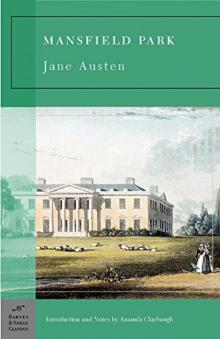 Mansfield Park (Barnes & Noble Classics Series)
Mansfield Park (Barnes & Noble Classics Series) Sense and Sensibility (Barnes & Noble Classics Series)
Sense and Sensibility (Barnes & Noble Classics Series)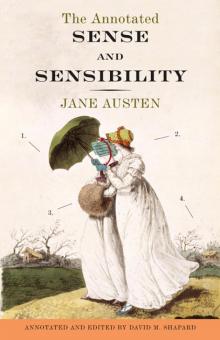 The Annotated Sense and Sensibility
The Annotated Sense and Sensibility Pride and Prejudice (Clandestine Classics)
Pride and Prejudice (Clandestine Classics)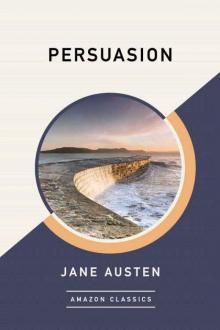 Persuasion (AmazonClassics Edition)
Persuasion (AmazonClassics Edition)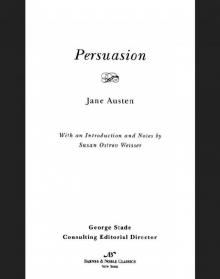 Persuasion (Barnes & Noble Classics Series)
Persuasion (Barnes & Noble Classics Series)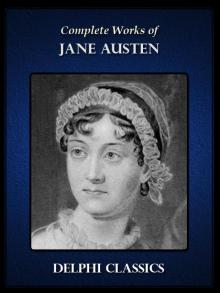 Complete Works of Jane Austen
Complete Works of Jane Austen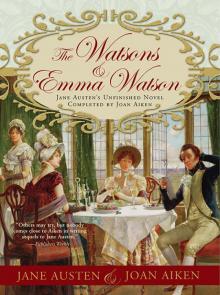 The Watsons and Emma Watson
The Watsons and Emma Watson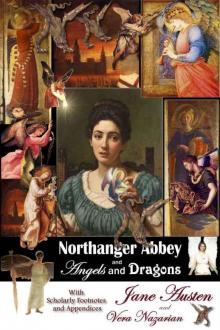 Northanger Abbey and Angels and Dragons
Northanger Abbey and Angels and Dragons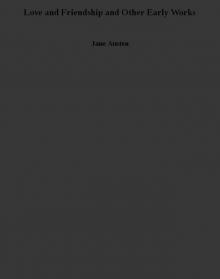 Love and Friendship and Other Early Works
Love and Friendship and Other Early Works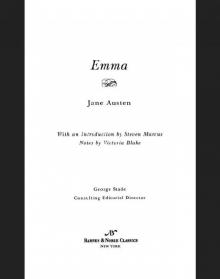 Emma (Barnes & Noble Classics Series)
Emma (Barnes & Noble Classics Series) Sanditon
Sanditon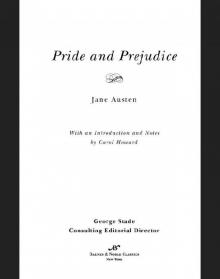 Pride and Prejudice (Barnes & Noble Classics Series)
Pride and Prejudice (Barnes & Noble Classics Series)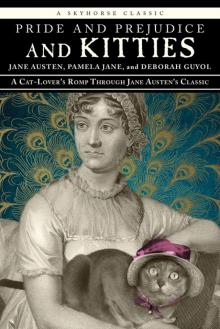 Pride and Prejudice and Kitties
Pride and Prejudice and Kitties The Annotated Northanger Abbey
The Annotated Northanger Abbey Oxford World’s Classics
Oxford World’s Classics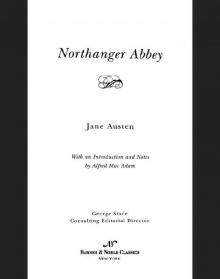 Northanger Abbey (Barnes & Noble Classics Series)
Northanger Abbey (Barnes & Noble Classics Series)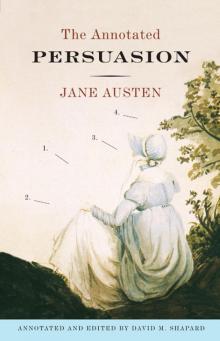 The Annotated Persuasion
The Annotated Persuasion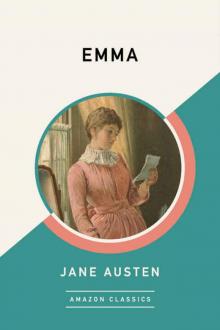 Emma (AmazonClassics Edition)
Emma (AmazonClassics Edition)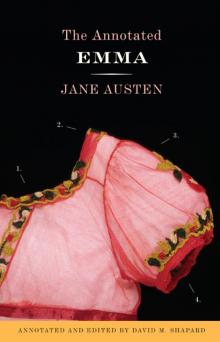 The Annotated Emma
The Annotated Emma The Annotated Mansfield Park
The Annotated Mansfield Park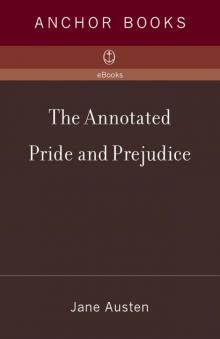 The Annotated Pride and Prejudice
The Annotated Pride and Prejudice